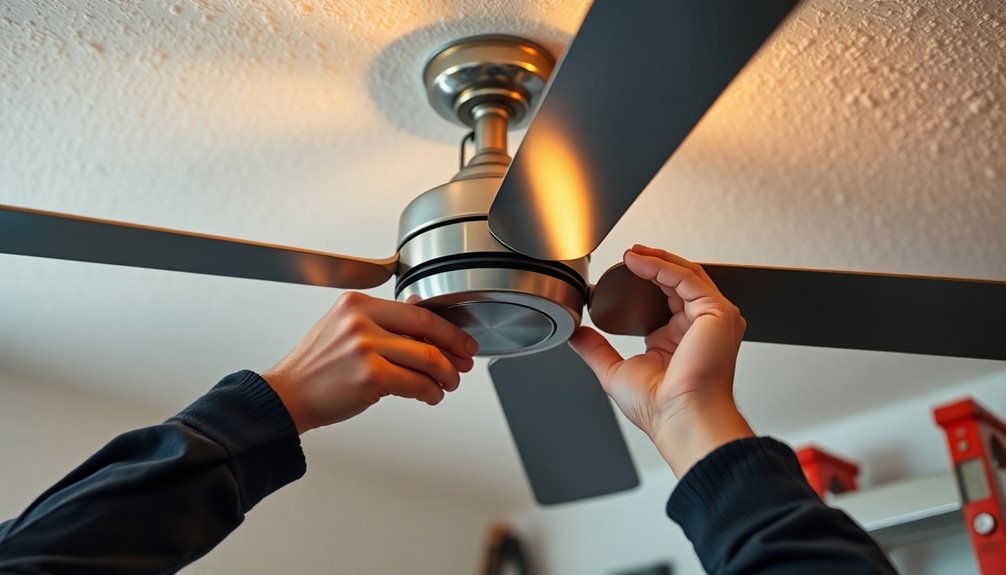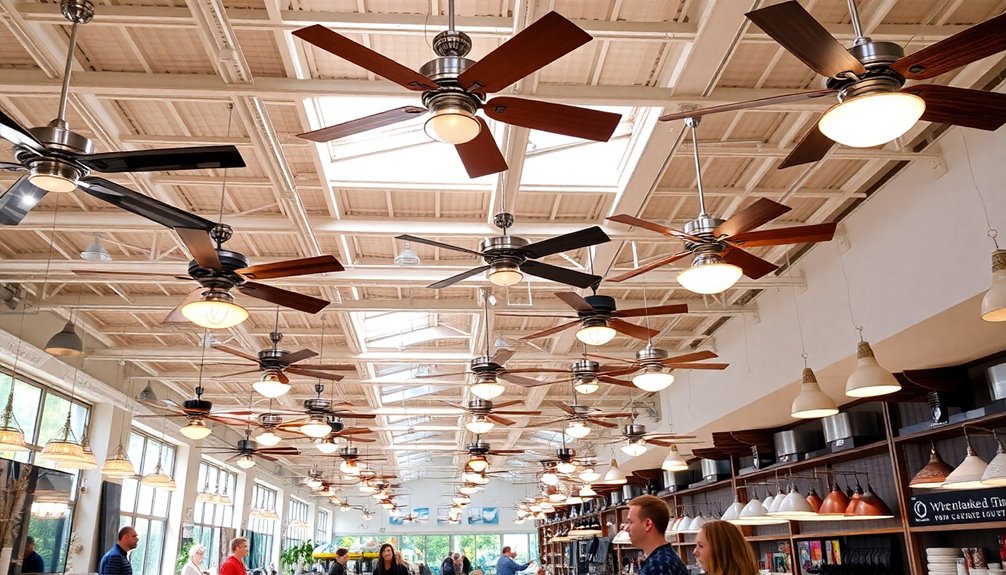Ceiling fan light bulbs vary in size, so you'll find options like A19, A15, and G-shaped bulbs. The A19 is a standard choice, fitting most modern fans, while the A15 is better for tighter spaces. G-shaped bulbs, like G25 and G16.5, offer decorative flair and are perfect for broader areas or candelabra bases. Remember, the base type matters too; most newer fans use an E26 base, while older ones might need E12 or E11. Choosing the right size and type is essential for safety and performance. Keep exploring, and you might uncover more tips on selecting the perfect bulbs!
Key Takeaways
- Common bulb sizes for ceiling fans include A19, A15, T12, G25, and G16.5, each suitable for different fan designs and spaces.
- The A19 bulb is the most versatile, fitting many modern ceiling fan light kits effectively.
- Bulb bases vary, with E26 being the most common for newer fans, while older models may require E12 or E11 bases.
- Wattage is crucial; standard incandescent bulbs range from 40-60 watts, while LEDs typically use 6-9 watts for similar brightness.
- Always measure existing bulbs' diameter in eighths of an inch and check fixture specifications for compatibility when replacing bulbs.
Types of Ceiling Fan Bulbs

When choosing bulbs for your ceiling fan, it's important to take into account the various types available. The most common option is the A19 bulb, which measures 2.375 inches in diameter and fits many modern ceiling fans. These bulbs typically come with a medium screw base (E26), making them compatible with newer models.
However, if you have an older fan, you might need different bulb sizes, such as E11 or E12, so it's essential to check the fixture specifications before purchasing.
Besides A19, other bulb shapes like A15, T12, and G25 can also be used depending on your fan's design and lighting needs. The shape and size of the bulbs you choose not only affect light distribution but also contribute to the overall aesthetic of your ceiling fan and room.
For instance, a G25 bulb can create a more decorative look, while a T12 might offer a more focused beam. Choosing the right bulb can enhance the functionality of your ceiling fan and improve overall room comfort(#).
Ultimately, understanding the various types of ceiling fan light bulbs and ensuring compatibility with your fixture will help you achieve the desired ambiance and functionality in your space.
Common Bulb Sizes

Choosing the right bulb size for your ceiling fan is essential for guaranteeing both functionality and style. The most common bulb size you'll encounter is the A19 bulb, which has a diameter of 2.375 inches and fits many standard fixtures.
However, there are several other bulb sizes you might consider for your ceiling fan light. Here are a few popular options:
- A15: Smaller than the A19, suitable for tighter spaces.
- T12: Tubular shape, often used for different lighting styles.
- G25: Larger globe-shaped bulb, great for open spaces.
- G16.5 bulbs: Ideal for decorative fixtures, typically compatible with candelabra bases.
Understanding these common bulb sizes helps you achieve the right balance between light distribution and aesthetic appeal.
Understanding Bulb Bases

Understanding the various bulb bases is vital for guaranteeing your ceiling fan light operates effectively. Most newer ceiling fan light bulbs use the E26 medium screw base, which is widely compatible and easy to find.
However, if you have an older model, you might need to check for different base sizes, such as E12 or E11. The bulb size is essential, as it's indicated by a code that specifies its shape and diameter. For instance, an A19 bulb shape has a 2.375-inch diameter, while an A15 shape is often required for ceiling fan fixtures to fit nicely with shades and decorative elements.
Always verify the specific bulb base type against your fan's socket to confirm proper fitting and functionality. Using the correct bulb base size isn't just about compatibility; it's also about safety.
Exceeding wattage limits can lead to overheating, putting your light fixture at risk for damage. Additionally, selecting the right bulb types can help manage your energy costs effectively, guaranteeing your ceiling fan lights operate efficiently without compromising safety.
Importance of Wattage

Wattage plays an essential role in the performance of your ceiling fan light bulbs, directly influencing both brightness and energy consumption. When selecting bulbs, understanding wattage helps you achieve the desired lighting while maintaining energy efficiency.
Here are some key points to take into account:
- Brightness: Higher wattage generally means more light, but energy-efficient LEDs can provide similar brightness at lower wattages.
- Standard Wattage: Incandescent bulbs for ceiling fans typically range from 40 to 60 watts, while LEDs equivalent to these only require about 6 to 9 watts.
- Maximum Wattage: Always adhere to the maximum wattage specified for your light fixture to avoid overheating and potential fire hazards, especially with older ceiling fan models.
- Dimmable Bulbs: If you choose dimmable bulbs, verify their wattage is compatible with the dimmer switch to prevent flickering and guarantee smooth operation.
Light Color and Temperature

The color temperature of your ceiling fan light bulbs can greatly affect the ambiance of your space. Choosing the right light color is essential for achieving the desired mood. Typically, you'll find warm white bulbs ranging from 2700K to 3000K, which create a cozy atmosphere. In contrast, cool white bulbs, with a color temperature of 3500K to 4100K, promote an energetic feel. If you want a natural look, consider daylight bulbs that mimic sunlight, ranging from 5000K to 6500K.
Here's a quick reference table to help you select the right color temperature for your lighting fixture:
| Light Type | Color Temperature (Kelvin) | Ambiance |
|---|---|---|
| Warm White | 2700K – 3000K | Cozy and Inviting |
| Cool White | 3500K – 4100K | Bright and Energetic |
| Daylight | 5000K – 6500K | Natural and Clear |
Many LED bulbs now offer color-changing capabilities, allowing you to adjust the temperature to suit your needs. When selecting bulbs, always consider the ambiance you want to create.
Quality of Light Bulbs

Quality plays an essential role when selecting ceiling fan light bulbs, as it directly impacts both performance and longevity.
Choosing the right bulb size and type is vital for achieving ideal lighting performance. Here are four key factors to keep in mind:
- Light Bulb Size: Make sure you select the correct size, such as A19, A15, T12, or G25, to guarantee compatibility with your fan's fixture.
- Maximum Wattage: Remember that incandescent bulbs can reach up to 60 watts, while LED ceiling fan bulbs typically use only 9 watts. This difference highlights the importance of energy efficiency.
- Bulb Shapes: Pay attention to bulb shapes to avoid light distribution problems. The right shape enhances your room's lighting and avoids fixture damage.
- Compatibility: Always check that the chosen bulb is compatible with your ceiling fan. This prevents frequent replacements and maintains consistent lighting quality.
Dimmable Options

When it comes to enhancing your ceiling fan's lighting, dimmable options offer a fantastic way to adjust brightness and set the mood in any room. Dimmable ceiling fan light bulbs allow for adjustable brightness settings, making it easy for you to create different atmospheres. You can choose warmer tones for cozy evenings or cooler tones to enhance focus and visibility.
Many of these options come in energy-efficient LED varieties, giving you a longer lifespan and lower energy costs compared to traditional incandescent bulbs. However, verify their compatibility with dimmer switches, as not all bulbs support this functionality. Checking specifications before purchasing is vital to avoid disappointment.
When selecting dimmable bulbs, keep an eye on their wattage. It's important to confirm that the wattage doesn't exceed your ceiling fan's maximum wattage limit. Exceeding this limit not only compromises performance but also increases the overheating potential, which can lead to safety hazards.
Choosing for Aesthetics

When you're selecting ceiling fan light bulbs, consider how they match your room decor and the design of the fixture.
The right bulb shape can enhance the overall aesthetic appeal, making your space feel more cohesive.
With options like A19, A15, and decorative shapes like G25, there's plenty of variety to suit your style.
Matching Room Decor
To create a cohesive and inviting atmosphere in your space, selecting the right ceiling fan light bulbs is crucial. When considering matching room decor, think about the shape, size, and finish of the bulbs. Here are some key factors to keep in mind:
- Light Bulb Base: Common options like A19 and G25 bulbs fit various aesthetics. A19 bulbs offer a classic look, while G25 bulbs add a decorative touch.
- Color Temperature: Opt for warmer bulbs (2700K-3000K) to create a cozy ambiance in living areas. Cooler bulbs (5000K-6500K) are better for task-oriented spaces, like kitchens.
- Brightness of the Bulb: Confirm the brightness complements your decor; dimmable LED bulbs can adjust to different moods and settings.
- Finish: Choose between frosted or clear bulbs. Frosted bulbs provide softer lighting that blends seamlessly with your decor, enhancing the overall aesthetic.
Light Fixture Design
Choosing the right light fixture design for your ceiling fan can elevate your space and enhance its aesthetic appeal. When selecting bulbs, consider the base size and style of light bulb that aligns with your ceiling fan's design. Common choices, like A19 bulbs for Hunter fans, guarantee ideal light distribution while maintaining visual harmony.
Popular shapes for ceiling fan lights include A, T, and G, each offering unique characteristics that can complement your decor. For decorative purposes, opting for dimmable LED bulbs not only provides functional lighting but also allows you to create mood lighting that enhances the overall atmosphere of the room.
It's essential to verify that the bulb shape and size match the fixture specifications. This alignment contributes considerably to the room's energy efficiency and aesthetic appeal.
Bulb Shape Variety
There's a wide variety of bulb shapes available for ceiling fans, each offering unique aesthetic benefits that can transform your space.
Choosing the right shape isn't just about looks; it also affects light distribution and overall functionality. Here are some popular options to evaluate:
- A19 Shape: Commonly used in Hunter fans, this versatile bulb has a diameter of 2.375 inches, fitting seamlessly into many ceiling fan light kits.
- G-Shaped Bulbs: Measured in eighths of an inch, G16.5 is a popular size for decorative fixtures, adding a stylish touch to your fan setup.
- Globe Shapes: These round bulbs provide a soft, diffused light, enhancing the ambiance while making a bold aesthetic statement.
- Candelabra Shapes: Perfect for traditional or vintage styles, these bulbs create an elegant look and are often used in ceiling fans with intricate designs.
Replacement Tips

When it comes to replacing ceiling fan light bulbs, getting the right size is essential for ideal performance. To guarantee a successful replacement, follow these tips:
- Identify the size: Check the existing bulb's shape and diameter, commonly indicated as A19 or A15. This helps in finding compatible replacements.
- Measure diameter: Use a ruler to measure the existing bulb's diameter in eighths of an inch for accuracy.
- Check the fixture: Always refer to the fixture specifications for compatibility. Different ceiling fan models may require specific bulb sizes and shapes.
- Base type matters: Most modern ceiling fans use a medium screw base (E26), but older models might need E12 or E11 bases.
- Wattage limit: Be cautious about the wattage limit on your fixture. Exceeding this can lead to overheating and potential damage.
Here's a quick reference table to help you:
| Aspect | Details |
|---|---|
| Size | A19, A15 |
| Base | E26, E12, E11 |
| Wattage | Check fixture |
| Compatibility | Refer to specs |
| Measurement | Diameter in eighths |
Frequently Asked Questions
What Size Light Bulb Do Ceiling Fans Take?
When you're choosing a light bulb for your ceiling fan, it's important to know the specific size and base required.
Many fans use standard bulbs like A19 with an E26 base, but older models might need different sizes.
Always check your fan's specifications before buying. This guarantees you'll get the right fit and peak performance.
Don't forget to take into account the bulb shape and wattage for the best lighting experience!
Are E26 and A19 the Same?
E26 and A19 aren't the same, although they often go together.
E26 refers to the base size, which measures 26 millimeters in diameter, while A19 describes the bulb's shape and size, approximately 2.375 inches wide.
You'll find many bulbs with an E26 base that fit an A19 shape, making them compatible for various fixtures.
Just remember to check both the base and shape to guarantee they match what you need for your lighting.
Are E12 and A15 the Same?
No, E12 and A15 aren't the same.
E12 refers to the bulb base size, specifically a candelabra base that's 12mm in diameter.
On the other hand, A15 describes the bulb shape, which has a diameter of 1.875 inches.
While an A15 bulb can have an E12 base, not all E12 bulbs fit the A15 shape.
Always check your fixture's specifications to verify compatibility when selecting the right bulb.
Does an A19 Bulb Fit in a Ceiling Fan?
Yes, an A19 bulb typically fits in most ceiling fans, especially those made after 2018.
You'll find that A19 bulbs have a medium E26 screw base, which matches standard fixtures.
However, it's essential to check your ceiling fan's specifications, as some older models might require different bulb sizes.
Always verify the maximum wattage limit for your fan to avoid any overheating issues and guarantee safe operation.
Conclusion
Now that you know about the various types of ceiling fan light bulbs, sizes, and wattage, you're ready to make your choice. But wait—what if you pick the wrong bulb? Imagine flicking the switch and nothing happens, or worse, a glaring light that ruins the cozy vibe. Don't let that happen! Take the time to contemplate your options, and you'll illuminate your space just right. The perfect bulb is out there, waiting for you to discover it!









